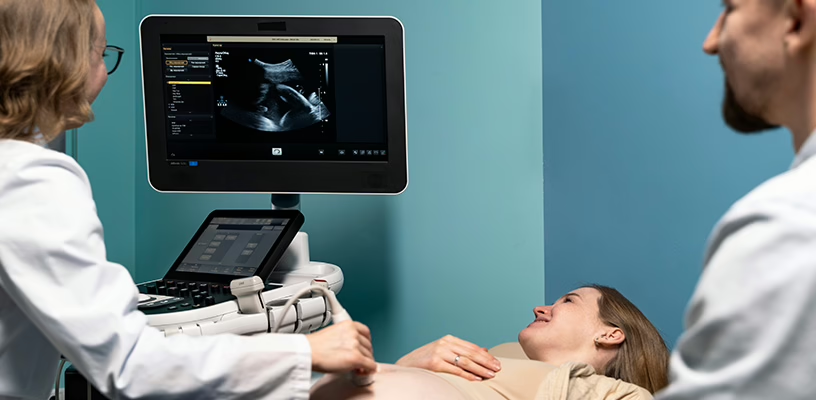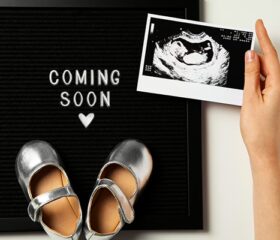Frequently Asked Questions about Ultrasound Due Dates

- How our calculator determines your due date from an ultrasound
- How will your doctor calculate your due date from your ultrasound?
- Can an ultrasound due date ever be incorrect?
- What’s the earliest you can see your baby on an ultrasound?
- What if your doctor can’t see your baby on an ultrasound?
- What other ultrasounds will you have during your pregnancy?
How our calculator determines your due date from an ultrasound
To figure out your due date, enter the date of your ultrasound and the gestational age your doctor reported to you after you got it.
Remember that these results are only estimates, and are no substitute for an expert opinion from your doctor or another medical professional.
Estimating your due date from an ultrasound vs. your last period
Usually, your doctor will use the date of your last menstrual period (LMP) to determine your estimated due date (EDD). With this method, they’ll count 280 days (40 weeks) from your LMP to get a rough idea of when your baby will be born.
This method is fairly reliable, but not perfect. It assumes that you:
- Have a regular menstrual cycle
- Can accurately remember the date of your LMP 1
If either of those isn’t actually the case, the method won’t work. What’s more, pregnancies can last anywhere from 37 weeks to 41 weeks, and if yours progresses slower or faster than average (instead of lasting exactly 40 weeks), it will throw the estimate off even further.
Using an ultrasound is a more reliable way to calculate your baby’s gestational age (i.e., how many weeks pregnant you are), and, correspondingly, your due date. 1
How will your doctor calculate your due date from your ultrasound?
Your doctor will determine your baby’s gestational age during your first-trimester ultrasound, which you’ll probably get when you’re between 6 weeks and 12 weeks pregnant.
They’ll do this by measuring your baby’s crown-to-rump length (CRL). Once they’ve worked out the average (the mean) of three CRL measurements, they’ll plug it into a formula that they’ll use to calculate your baby’s gestational age.
They’ll compare this with the EDD they attained from the date of your LMP. If your ultrasound-derived EDD differs from your LMP date by 7 days or more, your doctor will adjust your EDD to match the one attained from your scan. 1
Why is it important to know your due date?
Calculating your due date is more than just a way to figure out when your baby will make his debut. It’s an important tool that your doctor will use to assess your baby’s size and development. 2
It also allows you to make the right decisions about your prenatal care and lifestyle, which will change throughout your pregnancy. For instance, most airlines in the US won’t let you fly domestically once you’re 36 weeks pregnant, with an earlier cut-off for international flights. 3
Can an ultrasound due date ever be incorrect?
A pregnancy ultrasound is the most accurate way of calculating your due date. However, the earlier you get one, the more accurate your results will be (somewhat counterintuitively).
That’s because fetal growth in the second trimester (14 weeks to 27 weeks pregnant) is more variable. Not all babies grow to the same size, and their development past the first trimester depends more strongly on their genetics and environment. This makes it harder for your doctor to draw any conclusions about your EDD based on your growing baby’s size. 1
Regardless of when it’s calculated, remember that your estimated due date is just that: an estimate. As mentioned, you could be pregnant for longer than 40 weeks, or you could give birth earlier. There also may be instances where your doctor will need to induce labor earlier than 40 weeks, such as if you’re dealing with a dangerous pregnancy complication or are carrying multiples.
How does carrying multiples affect your due date?
If you’ve got more than one bun cooking in the oven, you’re statistically more likely to give birth earlier than with a singleton pregnancy.
Here’s when you’re most likely to give birth depending on how many multiples you’re carrying: 4
- Singleton (one baby): 39 weeks (gestational age)
- Twins: 35 weeks
- Triplets: 32 weeks
- Quadruplets: 30 weeks
- Quintuplets or more: 27 weeks
These figures are just averages, and your doctor will assess when you’re most likely to give birth based on your ultrasound findings.
What’s the earliest you can see your baby on an ultrasound?
Your doctor can see your baby on an ultrasound as early as week 6 of your pregnancy. However, you likely won’t get your first ultrasound until around 7 weeks (at the earliest) or 8 weeks pregnant. 5
Along with providing you with a more accurate due date, your doctor will use this early ultrasound to:
- Confirm your pregnancy by checking if your baby’s heartbeat has started
- Check whether you’re carrying multiples
- Rule out any early complications
What if your doctor can’t see your baby on an ultrasound?
If your doctor can’t find your baby on an ultrasound, that doesn’t necessarily mean something is wrong. It could be that you miscalculated the date of your LMP and that your pregnancy isn’t far along enough to see your baby yet.
Your doctor will book you for another ultrasound at a later date, the timing of which will depend on what they can see in your first scan: 6
- Gestational sac: If your doctor can only see your gestational sac (the fluid-filled structure that develops around your baby in early pregnancy), they’ll book another ultrasound two weeks later.
- Gestational and yolk sac: If your doctor can see your gestational and yolk sac (a membranous sac that nourishes your baby) without your developing embryo (fetal pole), they’ll book another ultrasound 10 days later.
- Fetal pole without cardiac activity: If your doctor can see your fetal pole but can’t identify a heartbeat, they may book another ultrasound 1 week later, depending on how large the fetal pole is.
It can be anxiety-inducing to have to wait for these later ultrasounds, but remember that each pregnancy develops at its own pace. Try not to stress out.
What early complications can occur during pregnancy?
Unfortunately, the first trimester is when you’re most at risk of pregnancy loss. It’s not always a problem if you can’t see your baby during an ultrasound, but it can sometimes be a sign of a miscarriage.
Some early forms of miscarriage can actually be dangerous for you, too, making an early ultrasound all the more important.
At this stage, you could be at risk of:
- Ectopic pregnancy: This happens when a fertilized egg implants outside of your uterus, usually in the fallopian tubes, although in rare cases, it can also show up in other locations (e.g., an ovary, a C-section scar, etc). 7 8 Ectopic pregnancies aren’t viable and almost always need to be terminated, as they can put you at risk of organ damage and death from hemorrhage.
- Molar pregnancy: This occurs when an egg and sperm join incorrectly during fertilization and create a tumor, which is usually (but not always) benign, meaning non-cancerous. Many molar pregnancies lead to miscarriage. However, if your pregnancy doesn’t end naturally, you may need to have the tumor surgically removed. 9
- Blighted ovum: This happens when a fertilized egg implants into your uterus, but doesn’t develop into an embryo. Although the embryo won’t develop, your gestational sac may still grow. You might have early pregnancy symptoms as a result of a blighted ovum, although it’s also possible you’ll miscarry before you ever realize you were pregnant. 10
A miscarriage is heartbreaking no matter which stage of pregnancy you’re at. If you’re dealing with pregnancy loss early on, there are resources out there you can contact, such as Share Pregnancy Support & Infant Loss Support.
What other ultrasounds will you have during your pregnancy?
After your first prenatal ultrasound, assuming your doctor identifies your baby and detects a heartbeat, your next one will usually be between 18 weeks and 20 weeks of pregnancy.
This ultrasound is often called the “anatomy scan.” 5 It’s also sometimes (incorrectly) called the “gender scan,” as it’s when many parents find out their baby’s gender (or, more accurately, their baby’s biological sex).
Your doctor can look for different features on your gender scan to determine your baby’s sex. Their ability to do this will depend on the position your baby is in during the ultrasound—if your baby’s legs are crossed, covering the genitals, you’ll have to wait until the next scan to find out.
Your doctor will also use this ultrasound to check on your baby’s overall health and make sure your pregnancy is progressing normally. If everything is progressing well, this may be the last ultrasound you have during your pregnancy (although that’s up to your doctor’s judgment). 5
Should you get an elective ultrasound?
Many moms-to-be are so excited at the prospect of seeing their babies that they opt for a non-medical ultrasound, called an elective ultrasound, just to get a picture showing his development.
While it’s understandable if you’d like a keepsake of your baby’s time in the womb, many medical and health organizations advise against non-medical ultrasounds, including the:
- Food and Drug Administration (FDA) 11
- American College of Obstetricians and Gynecologists (ACOG) 12
- American Institute of Ultrasound Medicine (AIUM) 13
By and large, the scientific and medical consensus is that you should avoid getting procedures that aren’t actually necessary, even ones that are probably harmless.
Article Sources
- American College of Obstetricians and Gynecologists. "Methods for Estimating the Due Date" Retrieved July 31, 2025.
- Baystate Health. "Due Dates are Rarely Accurate - So Why Do They Matter?" Retrieved July 31, 2025.
- American College of Obstetricians and Gynecologists. "Travel During Pregnancy" Retrieved July 31, 2025.
- Perinatology. "Pregnancy Due Date Calculator" Retrieved July 31, 2025.
- Cleveland Clinic. "Ultrasound in Pregnancy" Retrieved July 31, 2025.
- The University of Texas Southwestern Medical Center. "Patience is key: Understanding the timing of early ultrasounds" Retrieved July 31, 2025.
- MedlinePlus. "Ectopic Pregnancy" Retrieved July 31, 2025.
- The University of Texas Southwestern Medical Center. "Cesarean scar ectopic pregnancy: Facts and treatment options" Retrieved July 31, 2025.
- Cleveland Clinic. "Molar Pregnancy" Retrieved July 31, 2025.
- Cleveland Clinic. "Blighted Ovum" Retrieved July 31, 2025.
- U.S. Food & Drug Administration. "Ultrasound Imaging" Retrieved July 31, 2025.
- American College of Obstetricians and Gynecologists. "Ultrasound Exams" Retrieved July 31, 2025.
- American Institute of Ultrasound in Medicine. "Prudent Use and Safety of Diagnostic Ultrasound in Pregnancy" Retrieved July 31, 2025.





